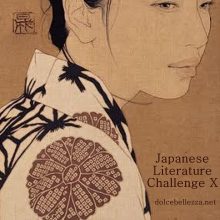It seems to be deeply rooted in human nature to put the strong and powerful on a pedestal for unconditional adoration and to push the weak and helpless down into the gutter to trample on just as unreservedly. Social history is full of examples of organised discrimination like slavery, the Indian caste system or less strict class structures. Japanese society is no exception. For centuries, the country knew different classes and religion justified their inequality with karma. Only in 1871 – after Japan was forced into dealing with Western civilisation – the lowest class called eta was renamed and given equal rights as commoners, but society didn’t change overnight. More than three decades later, the boy whose school years the first volume of The River With No Bridge by Sumii Sué relates has to learn that no matter how much he excels in his studies and in virtue, for people he’ll remain the filthy eta who should be avoided.
Sumii Sué (住井 すゑ) was born in the village Hirano (now: part of Tawaramoto) near Nara, Nara Prefecture, Japan, in January 1902. At the age of 18, she moved to Tōkyo to work with the publishing house Kodansha where she was subject to such unbearable discrimination as a working woman that she soon quit. In 1921, she married Inuta Shigeru (犬田卯), an activist in the proletarian agrarian movement and writer of “peasant literature”, and the same year she published her first novel 相剋 (Rivalry) under the name Sumii Sueko. Many other rural – anti-discrimination – novels followed along with short stories for adult readers as well as for children. As from the mid-1930s she ran a farm in Ibaraki Prefecture with her husband, raised four children and kept writing. The author was awarded the Mainichi Culture Prize for her novel 夜あけ朝あけ (Dawn-Daybreak) in 1954 and after her husband’s death in 1957 she set out to write her seven-volume masterpiece The River With No Bridge (橋のない川: 1961-1992) of which to date only the first volume has been translated into English. Sumii Sué died in Ushiku, Ibaraki Prefecture, Japan, in June 1997, working on the eighth volume of her novel.
Set in the (fictitious) village of Komori near Osaka between 1908 and 1914, The River With No Bridge is the story of Koji and his family consisting of mother, grandmother and brother Seitaro who is four years his senior. The boy’s father was killed in the Russo-Japanese war of 1904 and the two women take great pains not just to feed the children farming half an acre of rented land all by themselves and making straw sandals for sale, but to give them a good education that will allow them to escape their origins. Belonging to the reputedly unclean class of burakumin (new commoners), known as eta until 1871 and still depreciably called so, because they are or their ancestors were gravediggers, butchers and leatherworkers, they are outcasts of Japanese society. When six-year-old Koji enters school, he is hardly aware of this because nobody talks about it, it doesn’t take him long, though, to realise that he and all Komori children are treated with contempt. Schoolmates from the other villages avoid them, call them names and provoke them. If there is trouble, most of the teachers take it for granted that those from Komori are to blame and often punish them cruelly.
The central theme of The River With No Bridge clearly is everyday discrimination of the burakumin or eta in Japan because they are said to be tainted with bad karma. Just as the boy protagonist Koji gradually becomes aware of his low social status in the world outside his village and of all that it implies, the reader gets to see pain, hardship and limitations to which the defilement of the minority subjects the individual regardless of personal efforts. The novel is the more powerful because it’s laid against the very authentic backdrop of primary school life in Japan of the early 1900s with children who have already internalised the prejudices of their parents and with teachers who talk of equality without living it. In addition, it’s a pacifistic work reminding of another Japanese classic – namely Twenty-Four Eyes by Tsuboi Sakae (»»» read my review) – because Koji, the fatherless son of a war-hero, wonders ever again why going to war for the Emperor and being killed in action should be good and honourable as his teachers and books say. Also the flow of the narrative is similar lacking dramatic twists and turns because its focus is on the school boy’s daily life. The language is unpretentious and engaging.
For me it was a great pleasure to read The River With No Bridge by Sumii Sué. The book showed me a side of Japanese society that I wasn’t aware of because so far I had come across eta only as minor characters in a few historical novels set in feudal Japan. It’s interesting to see that for many decades after their emancipation in 1871 they suffered discrimination almost like before and it makes me wonder, if eta descendants keep having a hard time in the twenty-first century too… At any rate, this novel by a Japanese woman writer who is hardly known in the Western world deserves wider attention. Thus my verdict: highly recommended!
Set in the (fictitious) village of Komori near Osaka between 1908 and 1914, The River With No Bridge is the story of Koji and his family consisting of mother, grandmother and brother Seitaro who is four years his senior. The boy’s father was killed in the Russo-Japanese war of 1904 and the two women take great pains not just to feed the children farming half an acre of rented land all by themselves and making straw sandals for sale, but to give them a good education that will allow them to escape their origins. Belonging to the reputedly unclean class of burakumin (new commoners), known as eta until 1871 and still depreciably called so, because they are or their ancestors were gravediggers, butchers and leatherworkers, they are outcasts of Japanese society. When six-year-old Koji enters school, he is hardly aware of this because nobody talks about it, it doesn’t take him long, though, to realise that he and all Komori children are treated with contempt. Schoolmates from the other villages avoid them, call them names and provoke them. If there is trouble, most of the teachers take it for granted that those from Komori are to blame and often punish them cruelly.
“… A bitter little smile crossed Koji's young face, at the sight of which his grandfather felt a sharp pang: it showed that Koji was already aware of himself as an eta. Soshichi wanted to weep unrestrainedly; he wanted to face the invisible enemy that was trying to crush them as eta and strike out at such hatred with all his might. At the same time, he needed no one to tell him how utterly futile that would be.”Growing up, the two brothers have to cope with constant humiliation and hostility. While Seitaro begins to rebel against his scornful teacher, so his only choice after primary school is to start an apprenticeship in Osaka, quiet and studious Koji keeps his anger to himself and tries to understand what being eta actually means, what makes him despicable in the eyes of others. Koji also recognises as false certain “truths” taught in school, notably the glorification of the Emperor as kami and of heroic death in action, but he plays by the rules wanting to achieve something in life.
The central theme of The River With No Bridge clearly is everyday discrimination of the burakumin or eta in Japan because they are said to be tainted with bad karma. Just as the boy protagonist Koji gradually becomes aware of his low social status in the world outside his village and of all that it implies, the reader gets to see pain, hardship and limitations to which the defilement of the minority subjects the individual regardless of personal efforts. The novel is the more powerful because it’s laid against the very authentic backdrop of primary school life in Japan of the early 1900s with children who have already internalised the prejudices of their parents and with teachers who talk of equality without living it. In addition, it’s a pacifistic work reminding of another Japanese classic – namely Twenty-Four Eyes by Tsuboi Sakae (»»» read my review) – because Koji, the fatherless son of a war-hero, wonders ever again why going to war for the Emperor and being killed in action should be good and honourable as his teachers and books say. Also the flow of the narrative is similar lacking dramatic twists and turns because its focus is on the school boy’s daily life. The language is unpretentious and engaging.
For me it was a great pleasure to read The River With No Bridge by Sumii Sué. The book showed me a side of Japanese society that I wasn’t aware of because so far I had come across eta only as minor characters in a few historical novels set in feudal Japan. It’s interesting to see that for many decades after their emancipation in 1871 they suffered discrimination almost like before and it makes me wonder, if eta descendants keep having a hard time in the twenty-first century too… At any rate, this novel by a Japanese woman writer who is hardly known in the Western world deserves wider attention. Thus my verdict: highly recommended!
* * * * *
This review is a contribution to
(images linked to my reading lists):
(images linked to my reading lists):



The novel sounds fascinating. Especially given that every culture seems to enact this sort of discrimination. I want to read this.
ReplyDeleteYes, it's sad that already children have to deal with this sort of discrimination that has nothing to do with what a child does, how it slook etc. but just with into which social group it was born. As if life weren't hard enought to grasp even without it.... Showing the problem with the focus on a child growing up was certainly a great idea of the author! I hope that you'll like the book as much as I did.
DeleteAnd to all Japanese translators and publishers of Japanese literature out there: it would be nice to see also the remaining six volumes of the novel in translation one day, so I can read them!
This sounds like a novel with timeless themes, the main one of which is so pertinent today. I have such an ache in my heart for the unborn children who have no voice. But, I digress. It's just that your post triggered such sympathy for the powerless. It's a book I had not heard of before, and I'm so glad you brought it to my attention. Especially for this challenge of which you've been THE main participant. Thank you.
ReplyDeleteThanks for the compliment! I had hoped that my review would have this effect - the powerless need all the help that they can get! And it's ever so nice to see that I can find books that not everybody knows already.
DeleteOh, I just wished to contribute a book per month and since I'm reading so much, this wasn't much of a problem. To find Japanese twentieth-century classics from the pen of women, however, is always quite a challenge.
Good day! Do you use Twitter? I'd like to follow you if that would be ok.
ReplyDeleteI'm definitely enjoying your blog and look forward to new updates.